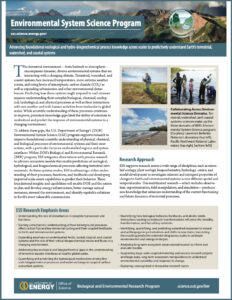Goal and Scope

Download Overview Brochure PDF.
The Environmental System Science (ESS) program advances an integrated, robust, and scale-aware predictive understanding of terrestrial systems and their interdependent biological, chemical, ecological, hydrological, and physical processes. ESS is part of the Earth and Environmental Systems Sciences Division (EESSD) within the U.S. Department of Energy’s Biological and Environmental Research (BER) Program. The ESS program seeks to develop an integrated framework using a systems approach to elucidate the complex processes and controls on the structure, function, feedbacks, and dynamics of terrestrial ecosystems that span from the bedrock through the rhizosphere and vegetation to the atmospheric interface.
The ESS program scope advances foundational process knowledge from molecular to global scales and the interplay of key system components to enable an improved understanding of understudied ecosystems and environmental interfaces such as coastal zones. This effort requires the linking of system components and their interfaces with ecological, watershed, and biogeochemical sciences to address key knowledge gaps across a range of spatial and temporal scales. Incorporation of process understanding into a range of models improves predictive understanding and future projections of the terrestrial system, which in turn enables the identification of new research questions and directions.
Approach
ESS builds off the success and approaches of the preceding Subsurface Biogeochemical Research (SBR) and Terrestrial Ecosystem Science (TES) programs. ESS research employs various approaches, including laboratory- and field-based experiments and modeling to enhance the understanding of terrestrial ecosystem and hydro-biogeochemical processes across a wide range of spatial and temporal scales. The program aims to improve the representation of ecological and hydro-biogeochemical processes in coupled models, thereby increasing the sophistication of the interpretations from model projections. The ESS coupled modeling-experimental (ModEx) approach is used for examining terrestrial system properties that exhibit large uncertainties in their functions, feedbacks, and dynamics, which are insufficiently captured in open-source or community models. Such models are used to generate predictions, and these are compared against observations or field experiments to identify critical uncertainties that can inform future observational and field research directions.

ESS research employs lab- and field-based experiments and modeling to enhance the understanding of ecosystem and hydro-biogeochemical processes across an enormous range of spatial (molecular to global) and temporal scales. [Courtesy Lawrence Berkeley National Laboratory]
Using an open-science and open-data philosophy, the ESS program advances priority research areas by supporting a complementary and coordinated mix of investments including university-led projects, next-generation ecosystem experiments (NGEE), national laboratory-led science focus areas (SFAs), and observation networks that represent short-term projects, decadal experiments, and long-term studies. The ESS program undertakes and integrates research across a wide range of disciplines (e.g., genomics, microbial ecology, plant ecology, biogeochemistry, geology, hydrology, and computational science), and applies state-of-the-art ecosystem manipulations to investigate inherent and emergent properties of changes to Earth and environmental systems. Through site observation, experimentation, field manipulation, and simulation, the ESS program uses the new knowledge gained to enhance the understanding of the current functioning and future dynamics of watershed and ecosystem processes in terrestrial systems.
ESS seeks to coordinate and collaborate closely with other research activities within BER’s EESSD and Biological Systems Science Division (BSSD), other DOE research programs, research efforts supported by other federal agencies, and capabilities available at DOE user facilities. Within BER, ESS activities coordinate with the Earth and Environmental System Modeling program’s activities to inform model capabilities such as the Energy Exascale Earth System Model (E3SM); the Atmospheric System Research program for understanding the atmospheric dynamics of land-atmosphere coupling; environmental microbiology research within BSSD; and the Data Management program’s data curation, archiving, and federation activities. ESS activities also support user facilities and resources to contribute to the broad EESSD and BER mission.
